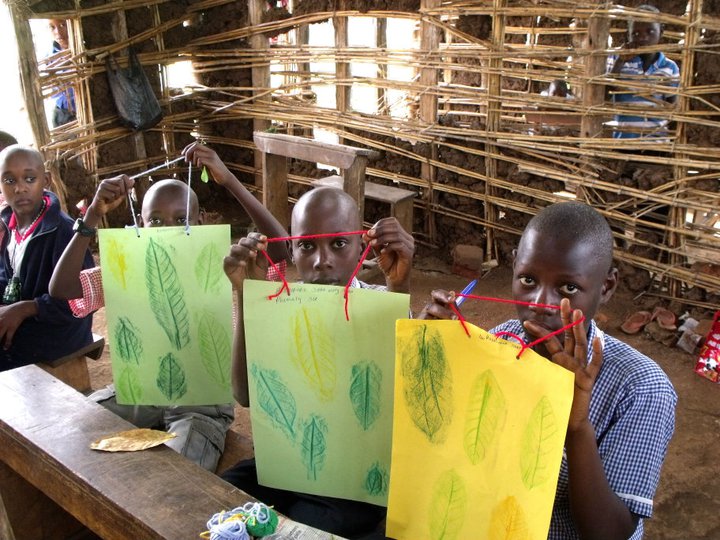After trekking for two days through a Thai bamboo jungle with a stomach bug, I arrived in a small Karen village. I was sick, muddy, sweaty, and exhausted. But the first thing that I did was find the children and took out the bubbles, crayons, and paper that had traveled all that way in my backpack. Fascinated village children gathered around, offering me gifts of green mangoes. I gave them a crayon and paper each, demonstrated how to do a leaf rubbing, and off they went, to explore their natural environment in a new and creative way.
I could not speak to them in Karen, but that didn’t matter (see: Beyond Language Barriers). It was at this moment that Nature Explorers International was truly born. I was in Thailand in May of 2004 to spend a month volunteering at Highland Farm and Gibbon Sanctuary. Although I loved the gibbons dearly, and had an amazing experience, it was working with local children that really connected with me in a way like nothing else.
I have now made leaf rubbing posters with children on nearly every continent. They are so easy, and can literally be done anywhere. All you really need is some paper and crayons!
Objective:
Summary: Children will gain a new awareness and understanding of the role of leaves in our world, learn an art technique, and create a beautiful wall hanging.
Concepts:
- Parts of a plant.
- What is a leaf?
- Parts of a leaf.
- How does a leaf help the plant?
- What are the veins?
- How to do a rubbing.
Materials:
- peeled crayons
- large construction paper (any kind of paper will actually do!)
- leaves
- hole punch (optional)
- Yarn (optional)
- Magnifying glasses (optional)
Procedure:
- The Parts of a plant
- Draw a diagram on the board as you talk about the major parts of a plant and their functions: roots, stem, leaves, and flower.
- What does a leaf do?
- Explain that a leaf catches sunlight so that a plant can make it’s own food.
- Photosynthesis happens inside of a leaf
- Describe the process of photosynthesis.
- Have the children clap their hands for each syllable of photosynthesis, repeat as a chant to encourage recognition of the word.
- The parts of a leaf
- Draw a diagram, or show the children leaf part cards for the following:
- Blade
- The broad, flat part of the leaf is the blade.
- Petiole
- The petiole attaches the leaf to the stem.
- Stipules
- The tiny leaflets at the base of the petiole.
- Margin
- The outside edge of the leaf.
- Veins
- Veins transport food and water through the leaf and provide support.
- Blade
- Draw a diagram, or show the children leaf part cards for the following:
- Go on a nature walk to find leaves, preferably ones that are already on the ground. Bring magnifying glasses to look closely at the parts of the leaf.
- Hand out one large piece of construction paper to each child.
- Put leaves and peeled crayons in the center of the table.
- Demonstrate the best way to do a rubbing:
- Feel the leaf for the veins and place it vein side up on the table.
- Place the paper over the leaf.
- Hold the peeled crayon flat and roll it over the leaf.
- Tips:
- try not to move the leaf,
- non-peeled crayons or colored pencils will work, just not as well.
- Punch two holes a few inches apart at the top center of the paper.
- Tie a piece of yarn to each hole to make a hanger.
- Tip: children love it if the yarn is long enough to go over their head.
Closure:
Assessment questions:
- Why are leaves important?
- What is their job?
- What are the parts of the leaf?
Take-home:
- Give out an ID sheet of different local leaves.
- Have children make a book about the parts of the leaf.
- Check out these free printable materials from Helpful Garden.
- Use these cards to show the parts of the leaf.
- Print and cut this template for your child’s book
Alternate versions:
- Laminate to make a placemat!
- Have children identify each leaf and write the name next to the rubbing.
- Fold and staple white paper inside to make a journal
- Use a smaller piece of paper and fold it in half to make a card.
- Tip: make cards for your friends from the places that you travel with unique local leaves.
























